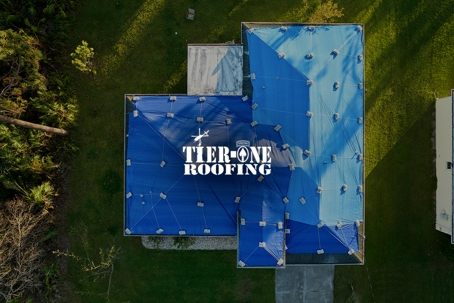Your Roof’s Silent Enemy: How Summer Heat Weakens It from the Inside Out
When people think about roof damage, they picture hailstorms or high winds. But what if we told you that one of the most destructive forces working against your roof is heat—and it’s coming from inside your home?
That’s right. Poor attic ventilation, trapped moisture, and unregulated heat buildup can shorten the life of your roof significantly. And in Oklahoma, where summer temperatures soar well over 100 degrees, those risks multiply fast.
At Tier-One Roofing, we’ve replaced plenty of roofs that didn’t fail because of storms—but because the attic turned into an oven.
Let’s walk through how this happens, why most homeowners never see it coming, and what you can do today to stop it.
The Science of Roof Failure from the Inside
Your roof system is made of layers—shingles, underlayment, decking, insulation, and the attic beneath. These layers are designed to work together. But when heat gets trapped in the attic, those layers start to break down.
Here’s what happens:
Hot air rises from your home into the attic.
Without proper ventilation, that air gets trapped.
Attic temperatures can reach 140–160°F by midday.
Prolonged heat exposure bakes your shingles from underneath.
Moisture gets trapped too, creating the perfect storm for mold and rot.
All of this can happen without a single drop of rain.
And once shingles start warping or adhesives fail, it doesn’t take much for the roof to start falling apart.
Signs You Have a Heat-Damaged Roof
Most people don’t know they have this issue until they see a leak. But by then, the damage is usually far worse than it looks.
Here are some early signs to watch for:
Wavy or rippled shingles: Caused by the plywood decking warping from excessive heat.
Peeling shingle corners: Indicates adhesives are drying out from underneath.
Musty attic smell: A warning sign of trapped moisture and poor airflow.
Sky-high energy bills: Your HVAC is overworking to counter attic heat.
Hot upstairs rooms: Uneven temperature control can mean insulation and airflow issues.
If you’re noticing one or more of these, don’t wait. A free attic and roof inspection from Tier-One Roofing can catch these issues before they cost you thousands.
Why Most Roofers Don’t Address This (But We Do)
Here’s the hard truth: many roofers ignore attic heat problems because they’re harder to solve.
It’s easier (and more profitable) to replace shingles and move on than to help homeowners fix ventilation issues that prevent damage long-term.
At Tier-One Roofing, we take a different approach. We inspect the full system—not just what you can see from the outside. That includes:
Checking for soffit blockages
Testing attic airflow
Evaluating insulation levels
Inspecting ridge vents and gable vents
If something isn’t working, we’ll tell you—and we’ll offer a real solution, not a band-aid.
That’s how we operate: long-term value, not short-term sales.
Oklahoma Heat and Shingle Life: The Harsh Reality
Here’s what summer heat does to even the best shingles:
Speeds up granule loss
Breaks down UV protective layers
Degrades asphalt oils
Causes thermal expansion and contraction
In short: it ages your roof years faster than expected.
And if your attic isn’t venting properly? That timeline gets cut in half.
This is why Tier-One Roofing always installs systems with top-rated ventilation and helps homeowners retrofit their attics when needed.
DIY Fixes That Don’t Work (And Might Make Things Worse)
A lot of homeowners try to address attic heat with quick fixes—like box fans, adding more insulation, or installing shiny new vents from a big box store.
The truth?
Insulation without airflow traps heat.
Fans without proper venting just circulate hot air.
Installing one vent doesn’t guarantee balance.
You need a balanced system of intake and exhaust. That’s why we treat every home like its own ecosystem—because what worked on your neighbor’s house might make things worse on yours.
How Tier-One Solves the Real Problem
Here’s what we do differently:
Full attic evaluation: We check for heat pockets, moisture, and ventilation imbalances.
Infrared inspection (when needed): To spot unseen moisture or insulation gaps.
Customized airflow plan: We ensure proper soffit-to-ridge venting or recommend gable solutions.
Roof materials matched to climate: Not every shingle holds up in our heat—we install ones that do.
System-first mentality: We don’t just replace a roof—we fix the system underneath it.
And we do all of this with no upsell pressure. Just facts, photos, and a clear plan of action.
What It Saves You (Short-Term and Long-Term)
Addressing internal heat damage isn’t just about saving your roof. It can:
Drop your energy bills by 10–30%
Extend your roof life by 5–10 years
Reduce risk of mold and structural rot
Improve home comfort year-round
Prevent storm-season failures
It’s peace of mind that pays for itself.
Let Tier-One Roofing give you that peace of mind—with a no-pressure, free inspection that looks where others don’t.
Don’t Let Summer Destroy What You Can’t See
Heat damage is sneaky. It doesn’t show up on the news. There’s no emergency alert. It just builds and builds until your roof buckles, your AC fails, and your wallet empties.
But it doesn’t have to be that way.
Call Tier-One Roofing today. Let’s inspect the whole system. Let’s fix what’s broken. And let’s give your home the defense it deserves—inside and out.

